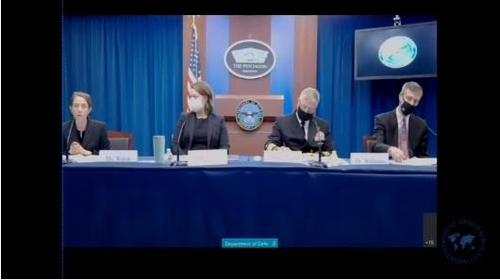 |
The image captured from the website of the US House Armed Services Committee shows Principal Deputy Assistant Secretary of Defense Jennifer Walsh (L) testifying before the Subcommittee on Intelligence and Special Operations in a hearing in Washington on Tuesday. (US House Armed Services Committee) |
WASHINGTON -- North Korea continues to build up its chemical and biological weapons, in addition to its other weapons of mass destruction (WMD) such as nuclear weapons that pose a serious threat to US forces and South Korean allies, a ranking US official said Tuesday.
Jennifer Walsh, principal deputy assistant secretary of defense for homeland defense and global security, also said North Korean leader Kim Jong-un may actually use such weapons in case of a conflict on the Korean Peninsula.
"North Korea's continued pursuit of nuclear, chemical, and biological weapons jeopardizes international stability and weakens the global nonproliferation regime. These capabilities pose a threat to US forces, allies," said Walsh in a statement submitted to the House Subcommittee on Intelligence and Special Operations.
"Given the risk that Kim Jong Un could seek to employ WMD in the course of or to stave off a conflict on the Korean Peninsula, the Joint Force must be ready for any number of WMD-related contingencies that require operating in a CBRN contaminated environment," she added.
CBRN stands for chemical, biological, radiological and nuclear.
Noting Pyongyang used chemical weapons in its successful assassination of leader Kim's brother, Kim Jong-nam, in Malaysia in 2017, Walsh noted the North, along with countries such as China, Russia and Iran, continue to advance chemical and biological weapons capabilities.
"The COVID-19 pandemic continues to demonstrate the threat posed by biological incidents. And scientific advances in biotechnology are creating new types of challenges while also lowering the barriers to entry for WMD development, proliferation, and use," she wrote.
Walsh said the US and South Korea are collaborating to counter any type of threat from North Korea.
"We are working with our Republic of Korea allies to ensure that we are ready for a WMD contingency, regardless of what the threat is," she said in Tuesday's hearing.
"We meet annually in a CWMD bilateral forum with our Republic of Korea counterparts so that we can ensure that we have trust and confidence," she added, referring to South Korea by its official name.
The Department of Defense official named China as one of the largest sources of chemical and biological weapons materials for North Korea and others.
"Chinese entities and individuals continue to transfer proliferation-sensitive materials to North Korea, Iran, and other threat actors, and China has demonstrated lax enforcement of domestic export controls and multilateral sanctions regimes intended to prevent such transfers," said Walsh.
In 2020, the US Army estimated the North had up to 5,000 tons of chemical weapons of approximately 20 different types, making it the third-largest possessor of chemical agents in the world. (Yonhap)






![[Herald Interview] 'Trump will use tariffs as first line of defense for American manufacturing'](http://res.heraldm.com/phpwas/restmb_idxmake.php?idx=644&simg=/content/image/2024/11/26/20241126050017_0.jpg)

![[Exclusive] Hyundai Mobis eyes closer ties with BYD](http://res.heraldm.com/phpwas/restmb_idxmake.php?idx=644&simg=/content/image/2024/11/25/20241125050044_0.jpg)